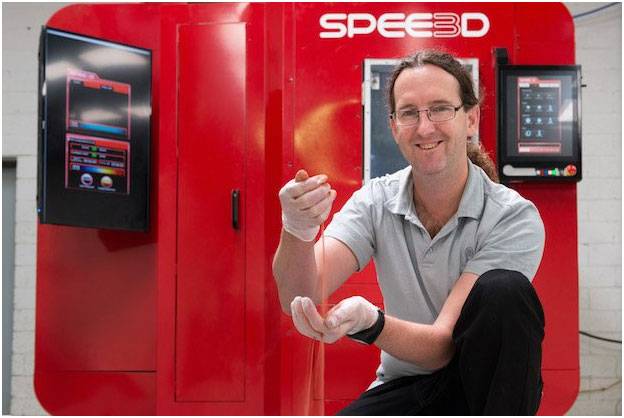[vc_row][vc_column][vc_column_text]The number of low-cost metal printing technologies that have arrived on the market over the last twelve months – Desktop Metal, Markforged, Xact Metal – indicates that one of the major barriers to mass adoption is starting to come down.
Speed is the next big hurdle, and as its name may suggest, an Australian start-up namedSPEE3D is targeting just that with a completely different approach to metal additive that can achieve speeds up to 1000 times faster than conventional laser-based systems.
This isn’t just any old startup – the company’s founders have the credentials to back up its lofty ambitions. CEO, Byron Kennedy and CTO, Steven Camilleri, have worked together for 15 years previously spinning off a company called In Motion Technologies from Charles Darwin University, raising capital and exiting to NYSE listed company, Regal Beloit who they worked with setting up production lines for electric motor company, Fasco Motors.
“We learned a lot about manufacturing in that process and really we saw 3D printing coming but in the world that we lived in, which was sort of commodity production or commodity manufacturing, the technology was just too slow and too expensive,” Byron told TCT. “So we really set ourselves a challenge. Could we solve that speed and cost issue? And thus the company SPEE3D was born.”
They came across a process that was already being used by the U.S. military for repairs called cold spray. With this method, air is accelerated at “supersonic speed”, or 1000 metres a second, and metal particles are injected. When particles hit the surface, the kinetic energy generated causes the particles to deform and stick, forming a part.
Byron commented: “We saw that technology and we then had to develop all of the software algorithms and the hardware to be able to build parts using this relatively known process.”
With investments from the Australian Government’s Accelerating Commercialisation program, Victorian and Northern Territory Governments, the resulting technology is called Supersonic 3D Deposition (SP3D) and its first machine is LIGHTSPEE3D. Described as the “world’s first fully integrated cold spray 3D printer”, it features a 300mm x 300mm build area, customised head on board a six-axis robot and does away with the need for inert gases commonly used in metal AM.
And it really is fast. A video of SPEE3D’s process shows a metal golf putter being produced in less than 10 minutes. Crucially, that’s just the “printing” portion, but SPEE3D isn’t shying away from AM’s “dirty secret” in promising speed and it is not out to reinvent the wheel in terms of design for manufacture. SPEE3D acknowledges the inevitable bug bear of additive manufacturing by allowing users to make parts they are already making, as fast as possible, knowing that no matter how you slice it, you are ultimately going to have to heat treat and post process.
“That’s what people actually want to do,” Byron explained. ““When you get into the real manufacturing world, people don’t want to have to use algorithms or special techniques to design high-end, high-cost parts. People want to make brackets, they want to make adapters, they want to make stuff which industry actually uses today and that’s where 3D printing hasn’t really targeted the parts that people want. Our vision is, we’re never going to be the poster child of 3D printing making stunning medical parts, we’re going to be in the backroom doing the heavy lifting, really making what industry wants. We don’t need PhDs to design the parts, you can build what you want and the reason for that is because it is a fast and low-cost process.”
Building on that familiarity even further, the machine uses standard metal powders, currently aluminium and copper. This keeps costs down even further compared to systems which require specially formulated metal powders. The next material on SPEE3D’s wish list is steel.
“This technology is suited to standard industry parts,” Byron said. “We are not focusing on high-end materials like stainless steel and Inconel, for us they’re niche markets, that’s where traditional 3D printing suits those very high, expensive, complex materials but that’s not us. We can absolutely do it, there’s no problem in terms of the technology, it’s just that we’re choosing a different end of the market to go after.”
The fact that those material choices are some of the most widely used in the industry is no happy coincidence. Byron insists that the technology is all about production and SPEE3D is targeting a market that’s already been infiltrated by 3D printing, and worth around $90billion; casting. SPEE3D believes the process, including setup, print and finish, can cut down the traditional time taken for casting production – up to 10 weeks – down to just 90 mins.
“Our focus is on aluminium parts at this time,” Byron explained. “The reason for that is, aluminium is used everywhere in industry today in some big markets, automotive, aerospace and then also general industry. What we’re doing here is making additive manufacturing or 3D printing cost comparative with cast parts, that’s really our target.”
The technology has already been successfully installed at Charles Darwin University but the official launch of LIGHTSPEED is set for formnext powered by tct. Pricing and availability details are expected to be announced around the show where SPEE3D will be exhibiting on stand C90 in Hall 3.0 of Messe Frankfurt on 14-17th November.[/vc_column_text][vc_single_image image=”1879″ img_size=”full” add_caption=”yes” alignment=”center”][/vc_column][/vc_row]
The AM Chronicle Editorial Team is a collective of passionate individuals committed to delivering insightful, accurate and engaging stories to additive manufacturing audiences worldwide.



